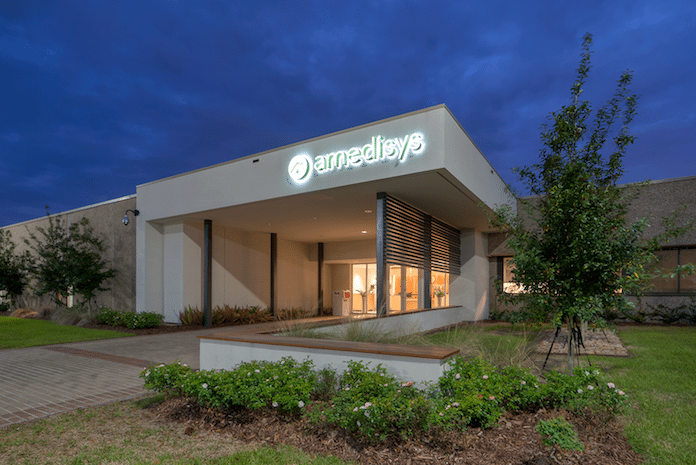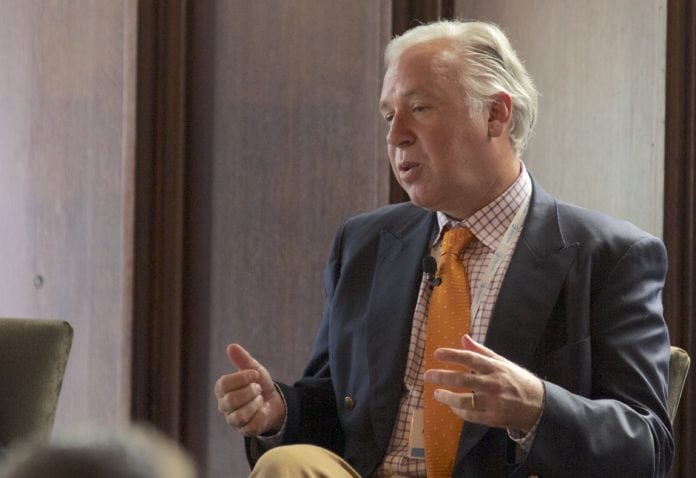Baton Rouge, Louisiana-based Amedisys Inc. (Nasdaq: AMED), one of the largest independent home health care companies in the country, had a successful 2018 and is looking to maintain the momentum in the year ahead.
The company’s ambitions include a heightened focus on risk-taking arrangements with payers and building on the tech investment it made in 2018, while preparing for potential industry-wide disruption by Google, Amazon, Apple and other technology powerhouses.
Amedisys will also continue to pursue hospice deals in the year ahead, sourcing them internally and avoiding competitive bid processes, CEO and President Paul Kusserow told Home Health Care News. At the same time, the company will attempt to navigate the stormy regulatory waters caused by the Patient-Driven Groupings Model (PDGM) and its controversial behavioral adjustments.
HHCN recently caught up one-on-one with Kusserow to discuss Amedisys’ plans and expectations for 2019. Highlights from that conversation are below, edited for length and clarity. HHCN plans on publishing forward-looking interviews with other major home health care industry executives in weeks to come.
HHCN: You’ve led Amedisys through a pretty substantial four-year turnaround, with 2018 probably being the best year yet since taking over in 2014. Looking back, how would you sum up last year?
Kusserow: It was a fantastic year. We produced huge growth, both in hospice and home health. Our margins turned out to be fantastic and our quality scores very high — the highest they’ve ever been. Our turnover [rate], too, was really low — around the high teens.
We feel good about how we’re taking care of patients and our financial performance.
What were some of the top things that stood out to you in 2018? Top of mind for me is the Compassionate Care Hospice agreement.
What’s been good for us is that we announced a major deal. It’s going to change the composition of the company and put equal weight on hospice, which I think is going to be good for us, particularly heading into 2020.
We put our toe in the water in terms of building out analytical tools, doing that with the investment in Medalogix. Something else that’s important coming out of 2018 is that we have four types of risk deals in 15 states. We’re just at the beginning there.
But apart from that, 2018 was just about doing the basics really well — patient satisfaction, quality, turnaround, productivity. All of that has resulted in strong numbers and good results.
2018 is in the rearview mirror. Our readers want to know about 2019. What’s one major trend that you expect to see in 2019 and why?
The biggest trend will be preparation — or not — for PDGM. I think there will still be a lot of lobbying work that needs to be done with Congress, with the Centers for Medicare & Medicaid Services (CMS) and with the White House, trying to see if anything can be done to take some of the stuffing out of PDGM. It’s fundamentally over-aggressive and overzealous in reach.
We have a new Congress, of course. Do you think that’s a positive, a negative or unknown at this point?
I’d say that it means not much. We have both sides of Congress — both sides of the House — for the legislation we’re pitching. We anticipated what would happen in the House. The Senate side of things is still secured by Republicans. We’re still hoping to introduce legislation that fundamentally pushes elements of PDGM — mainly the behavioral assumptions — back.
I think this year is going to be devoted to PDGM preparation and, at the same time, trying to pull elements of PDGM back. We’re preparing like PDGM is going to be implemented as is. We’re preparing for a worst-case scenario. Frankly, if it is a worst-case scenario, we’ll still be in pretty good shape.
We’ve covered PDGM extensively, so I don’t want to spend too much more time on that, even though it is such a big issue. What’s another trend? Putting PDGM aside, what’s something else you foresee for 2019?
At least for us, continuing desire to work with Medicare Advantage (MA) plans and get paid better, find new ways to work better with MA. Fee-for-service, while it’s still increasing due to the baby boomers aging, growth is much slower. If you look at Medicare Advantage, it’s increasing in its penetration of the overall Medicare population.
Somebody has got to solve that problem — and we’re spending a lot of time on it. As I just mentioned, we have various pilots out there on gain share programs, which we see as very important.
 Courtesy Amedisys
Courtesy AmedisysI’d say the increasing penetration of Medicare Advantage will eventually drive home health either to incredibly strong competition for fee-for-service business — or looking for more risk-based models, long-term risk-based models. We’ve been having a lot of conversations there.
Another trend you’re going to see from us: an increasing desire to partner with a variety of risk-taking entities. That means specialty companies that are starting to take risk and payers in general. Doctors groups. There will be more of a movement toward risk.
The discrepancy between fee-for-service pay and Medicare Advantage pay is going to be extraordinary. It’s $125 to $160 on average.
We recently put together a list of our top Home Health Care News stories from 2018. Of the top 10, I want to say five or six were related to MA.
Exactly. I’m shifting gears a little bit, but the other thing going on, at least in our perspective, is the drive towards — and this will help in both PDGM and in risk taking — a desire to use data more effectively in patient care. We need to increase our understanding of data and predictive analytics, using data to push better clinical and financial outcomes.
We’re doing a lot of work on that with Medalogix, but we’re looking for other solutions out there.
PDGM. Medicare Advantage. What else do you see coming down the pike in 2019?
I think people are watching to see if the relationship between Kindred and Humana Inc. (NYSE: HUM) will be a success. I know other payers are watching it — and I know home health agencies are watching to see if this is something that works for a large insurer and big home health or hospice company.
I think people are cautiously watching to see how this relationship evolves, to see the benefits of it. If the perception is that it’s been a big success, I think you’ll see more partnerships and/or acquisitions by payers for home health organizations.
We’re also seeing a lot of other entities that want to be in the home reaching out to do partnerships. I think there will be a lot of creative partnerships out there with retailers, specialty disease management companies and all sorts of organizations.
It really does seem that everybody is targeting the home. I guess that’s not surprising, though, as we always hear how older adults want to age in place, how the home is the safest and lowest-cost setting when it comes to health care. That includes tech titans like Amazon and Google. I think in December we covered rumors about Amazon trying to get in the medical home testing space, in fact.
I know the guy over at Amazon (Nasdaq: AMZN), and he’s a pretty smart guy. I think they’re just going to deliver packages for now, but it’s my sense that with their licensing, they’re going to start to move into the pharmaceutical home space and then they’ll start to figure things out around that. We’ll have to service some of those people, so they’ll likely eventually get to the home.
The other technology companies are doing the same. We’ve been talking to Google, for example, who wants to build a home presence so that everything can be done in the home, obviously care included.
Who do you think the biggest ‘disruptor’ in the home care space is between Google, Amazon and maybe even Apple?
Amazon is a delivery company and a logistics company. Largely, what we’ve seen and talked to them about has been about that — how to deliver. They’re all about products. They don’t really at this point provide services or people. They’re about the product. Amazon seems wary about moving into the people or services business because they like moving stuff better. They know how to move stuff from here to there.
Google is approaching it from a pure technology perspective, which is about how to take technologies and build smart homes. We’ve seen — at least in the health space — much more activity with them and Amazon than we have with Apple.
I’d say Google.
When I think about the delivery of products and start thinking about supply chain, I think about hospital-at-home. HHCN has heard in the past how supply-chain management is a barrier when it comes to growth in hospital-at-home programs in the U.S.
Look at Walmart. Look at Walgreens. Look at CVS. They’re all in the same space, particularly for DME. I agree with you. But we have a hospital-at-home product that we started a long time ago that we put on the shelf. We’re thinking it’s time to pull it back off the shelf.
 James Kruml/for Home Health Care News
James Kruml/for Home Health Care NewsThere are very few successful hospital-at-homes that have scaled because it’s a hard business to scale. I think it’s a great concept and makes total sense.
What are some other points of friction that you see for home health providers in the year ahead?
I think the whole fee-for-service model. If you’re going to start to take care of chronically ill people, a fee-for-service model is pretty limited. If you’re going to take care of somebody over a series of years, how does that actually work within the existing model, within the existing 60-day model? It’s difficult. That’s going to be a big challenge. Thinking outside of that box and providing care outside of that box. To take care of somebody over time, you also need to have the appropriate tools, a good mix of labor, otherwise it will get very expensive if you’re just throwing RNs and LPNs at it.
Anything else you’d like to note while we’re chatting?
I still think M&A is going to continue to be largely driven by private equity. I think the pricing of M&A is going to continue to be high, particularly in hospice. I don’t see it in home health until after PDGM hits. After PDGM hits, I think there will be a lot of activity from a PE perspective.
We’ve talked about this before, but is the plan for Amedisys going to be sourcing deals internally still? I know that’s what you did for the Compassionate Care Hospice move at least.
Yes. We have a pipeline already. We’re optimistic that we’ll get some more deals done in 2019.




